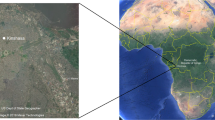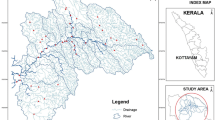Abstract
Efficient management of deteriorating water bodies can be achieved by determining the sources of faecal pollution. Resourceful techniques for discrimination of the sources of Escherichia coli in surface water have recently been developed, including the use of river water to facilitate faecal indicator surveillance, identification of sources of faecal contamination and employing relevant management practices to maintain water quality. This study was conducted to employ microbial source tracking (MST) techniques for the determination of the sources of faecal pollution based on a water quality investigation of the physico-chemical characteristics and coliform count point of the Tirumanimuttar River. To accomplish this, an MST library-based antibiotic resistance analysis, serotyping and the genomic tool rep-PCR techniques were applied, and the obtained results were analysed statistically. Among 135 and 70 E. coli isolates present in the library and water samples collected from the river and nearby well water sources, respectively, most showed intrinsic, high or moderate resistance to antibiotics. Isolates from human and pig faecal sources were 92% homologous with the samples from the river, whereas isolates from sewage and dairy cattle showed 89% and 80% homology, respectively. These findings indicated that the Tirumanimuttar River is subjected to stress from anthropogenic activities and runoff contaminated with agricultural and human faecal contamination. The sources of faecal pollution identified in this study may facilitate the monitoring and management of the Tirumanimuttar River.




Similar content being viewed by others
References
Ahmed, W., Stewart, J., Gardner, T., Powell, D., Brooks, P., Sullivan, D., et al. (2007). Sourcing faecal pollution: a combination of library-dependent and library-independent methods to identify human faecal pollution in non-sewered catchments. Water Research, 14, 3771–3779.
American Public Health Association (APHA). (1998). Standard methods for the examination of water and wastewater, 20th edition. L. S. Clesceri, A. E. Greenberg, A. D. Eaton, & M. A. H. Franson (Eds.). Washington DC.
Bergey's manual of systematic bacteriology. (1984). G. M. Garrity, D. R. Boone, R. W. Castenholz (Ed.). Williams & Wilkins: Baltimore.
Blanco, J., Blanco, M., Gonjalez, E. A., Blanco, J. E., Alonso, M. P., Garabal, J. I., et al. (1993). Serotypes and colonization factors of enterotoxigenic E.coli isolated in various countries. European Journal of Epidemiology, 9, 489–496.
Burnes, B. S. (2003). Antibiotic resistance analysis of faecal coliforms to determine faecal pollution sources in a mixed-use watershed. Environmental Monitoring and Assessment, 85, 87–98.
Cheng, D. R., Sun, H. C., Xu, J. S., & Gao, S. (2006). PCR detection of virulence factor genes in Escherichia coli isolates from weaned piglets with edema disease and/or diarrhea in China. Veterinary Microbiology, 115, 320–328.
Cimenti, M., Hubberstey, A., & Biswas, N. (2005). Evaluation of Microbial Indicators for the Determination of Bacterial Groundwater Contamination Sources. Water, Air and Soil Pollution, 168(1–4), 157–169.
Clinical and Laboratory Standards Institute. (2006). Methods for dilution antimicrobial susceptibility tests for bacteria that grow aerobically; Approved Standard, M7–A7, 7th Edn Wayne, PA, USA.
Clinical and Laboratory Standards Institute. (2006). Performance standards for antimicrobial disk susceptibility tests; Approved Standard, M2–M9, 9th Edn, Wayne, PA, USA.
Department of Public Health and Preventive Medicine, Tamilnadu. http://www.tnhealth.org/dphdb.htm.
Donna, F., Darner, R., Gifford, A., & Stoeckel, D. (2001). Evaluating water quality at public beaches for the protection of public health. In: Great Lakes Beach Conference Proceedings (pp. 49–63). Chicago: Great Lakes Beaches Association.
Ghumman, A. R. (2010). Assessment of water quality of Rawal Lake by long-time monitoring. Environmental Monitoring and Assessment, 180(1–4), 115–126.
Gowal, D., Saxena, S. N., Gowal, K. N., Ahuja, S., John, P. C., Mago, M. L., et al. (1984). Enterotoxigenicity of different Escherichia coli serotypes from cases of infantile and childhood diarrhea. Indian Journal of Pediatrics, 51, 35–38.
Griffin, P. M., & Tauxe, R. V. (1991). The epidemiology of infections caused by Escherichia coli O157: H7, other enterohemorrhagic Escherichia coli and associated hemolytic uremic syndrome. Epidemiological Reviews, 13, 60–98.
Griffith, J. F., Weisberg, S. B., & McGee, C. D. (2003). Evaluation of microbial source tracking methods using mixed fecal sources in aqueous test samples. Journal of Water and Health, 1, 141–151.
Hartel, P. G., Summer, J. D., Hill, J. L., Collins, J. V., Entry, J. A., & Segars, W. I. (2002). Geographic variability of Escherichia coli ribotypes from animals in Idaho and Georgia. Journal of Environmental Quality, 31, 1273–1278.
Harwood, V. J., Whitlock, J., & Withington, V. (2000). Classification of antibiotic resistance patterns of indicator bacteria by discriminant analysis: use in predicting the source of faecal contamination in subtropical waters. Applied and Environmental Microbiology, 66, 3698–3704.
Johnson, L. K., Brown, M. B., Carruthers, E. A., Ferguson, J. A., Dombek, P. E., & Sadowsky, M. J. (2004). Sample size, library composition, and genotypic diversity among natural populations of Escherichia coli from different animals influence accuracy of determining sources of faecal pollution. Applied and Environmental Microbiology, 70(8), 4478–4485.
Khurana I. & Sen R. (2008). Drinking water quality in rural India: Issues and approaches. WaterAid India.
Malik, A., Hasani, S. E., Shahid, M., Khan, H. M., & Ahmad, A. J. (2003). Nosocomial Klebsiella infection in neonates in a tertiary care hospital: protein profile by SDS-PAGE and Klebocin typing as epidemiological markers. Indian Journal of Medical Microbiology, 21(2), 82–86.
McLellan, S. L. (2004). Genetic diversity of E. coli isolated from urban rivers and beach water. Applied and Environmental Microbiology, 70, 4658–4665.
Mieszkin, S., Furet, J. P., Corthier, G., & Gourmelon, M. (2009). Estimation of pig faecal contamination in a river catchment by real-time PCR using two pig-specific Bacteroidales 16S rRNA genetic markers. Applied and Environmental Microbiology, 75(10), 3045–3054.
Milovanovic, M. (2007). Water quality assessment and determination of pollution sources along the Axios/Vardar River, Southeastern Europe. Desalination, 213, 159–173.
Mohapatra, B. R., & Mazumder, A. (2008). Comparative efficacy of five different rep-PCR methods to discriminate Escherichia coli populations in aquatic environments. Water Science and Technology, 58(3), 539–547.
Olivas, R., & Faulkner, B. R. (2008). Fecal source tracking by antibiotic resistance analysis on a watershed exhibiting low resistance. Environmental Monitoring and Assessment, 139, 15–25.
Rakesh Kumar, R., Singh, D., & Sharma, K. D. (2005). Water resources of India. Current Science, 89(5), 794–811.
Ratchtrachenchai, O., Subpasu, S., Hayashi, H., & Bathein, W. (2004). Prevalence of childhood diarrhoea associated Escherichia coli in Thailand. Journal of Medical Microbiology, 53, 237–243.
Ritchey, S. A., & Coyne, M. S. (2009). Applying mar analysis to identify human and non-human faecal sources in small Kentucky watersheds. Water, Air, and Soil Pollution, 196, 115–125.
Sayah, R. S., Kaneene, J. B., Yvette, Johnson, & Miller, R. A. (2005). Patterns of antimicrobial resistance observed in Escherichia coli isolates obtained from domestic- and wild-animal faecal samples, human septage, and surface water. Applied and Environmental Microbiology, 71(3), 1394–1404.
Simpson, J., Santo Domingo, J., & Reasoner, D. (2002). Microbial source tracking: State of the Science. Environmental Science & Technology, 36(24), 5279–5288.
Sinton, L. W., Finlay, R. K., & Hannah, D. J. (1998). Distinguishing human from animal faecal contamination in water: a review. New Zealand Journal of Marine and Freshwater Research, 32, 323–348.
Smith, A., Sterba-Boatwright, B., & Mott, J. (2010). Novel application of a statistical technique, Random Forests, in a bacterial source tracking study. Water Research, 44, 4067–4076.
Somarelli, J. A., Makarewicz, J. C., Sia, R., & Simon, R. (2007). Wildlife identified as major source of Escherichia coli in agriculturally dominated watersheds by BOX A1R-derived genetic fingerprints. Journal of Environmental Management, 82, 60–65.
Srinivasamoorthy, K., Chidambaram, S., Sarma, V. S., Vasanthavigar, M., Vijayaraghavan, K., Rajivgandhi, R., et al. (2009). Hydrogeochemical characterisation of groundwater in Salem district of Tamilnadu, India. Research Journal of Environmental and Earth Sciences, 1(2), 22–33.
Tambekar, D. H., Ansingkar, V. M., Tambekar, S. D., & Banginwar, Y. S. (2008). Microbial source tracking through antibiotics resistance profile for detection of faecal pollution in water. Journal of Applied Sciences Research, 4(11), 1496–1501.
U.S. Environmental Protection Agency. (2005). Microbial Source Tracking Guidance Document EPA/600/R-05/064.
Vasanthavigar, M., Srinivasamoorthy, K., Vijayaragavan, K., Rajiv Ganthi, R., Chidambaram, S., Anandhan, P., et al. (2010). Application of water quality index for groundwater quality assessment: Thirumanimuttar sub-basin, Tamilnadu, India. Environmental Monitoring and Assessment, 171, 595–609.
Wani, S. A., Bhat, S. M. A., & Nishikawa, Y. (2006). Shiga toxin producing Escherichia coli and enteropathogenic Escherichia coli in healthy goats in India: occurrence and virulence properties. Journal of Applied Microbiology, 100(1), 108–113.
Wheeler, A. L., Hartel, P. G., Godfrey, D. G., Hill, J. L., & Segars, W. I. (2002). Potential of Enterococcus faecalis as a human faecal indicator for microbial source tracking. Journal of Environmental Quality, 31, 1286–1293.
WHO. (2004). Water, sanitation and hygiene links to health: facts and figures. Geneva: World Health Organization.
Yan, T., & Sadowsky, M. J. (2007). Determining sources of faecal bacteria in waterways. Environmental Monitoring and Assessment, 129, 97–106.
Acknowledgements
We sincerely thank Dr. Mani and Dr. Yashwant Kumar, Central Research Institute, Kasouli, India, for their help with serotyping.
Author information
Authors and Affiliations
Corresponding author
Rights and permissions
About this article
Cite this article
Murugan, K., Prabhakaran, P., Al-Sohaibani, S. et al. Identification of source of faecal pollution of Tirumanimuttar River, Tamilnadu, India using microbial source tracking. Environ Monit Assess 184, 6001–6012 (2012). https://doi.org/10.1007/s10661-011-2398-7
Received:
Accepted:
Published:
Issue Date:
DOI: https://doi.org/10.1007/s10661-011-2398-7




